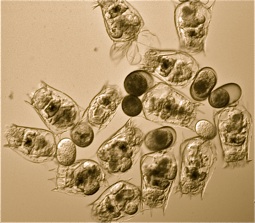green alga Chlamydomonas reinhardtii) enable us to follow evolutionary change and ecological dynamics at the same time for dozens of generations. We link ecological and evolutionary change to dynamics on the genomcis and transcriptomic level to improve our understanding of genes and molecular mechanisms that underlie adaptive evolutionary responses on the time-scale of the ecological and environmental changes that evoke rapid evolutionary responses.

ECO-EVOLUTIONARY DYNAMICS
WHY SEX?
Explaining the prevalence of sexual reproduction over asexual reproduction across animals and plants is an ongoing challenge in evolutionary biology. While numerous mechanisms have been hypothesized to explain the evolution of sex, there is still no conclusive understanding of the conditions under which sex is beneficial. Because sexual reproduction comes with several disadvantages – the so-called costs of sex – the predicted conditions for sex to be advantageous are often limited. Despite extensive study, there is little empirical support for any of these theories. Indeed, tests of theory through experimental evolution of sex

Evolution in action has recently been recognized as an important player for many ecological interactions. It is now well recognized that evolutionary change can affect the interactions between species within a few generations and that ecological interaction may influence the outcome of evolution in return. However, the concept of these so-called eco-evolutionary dynamics has not been fully integrated into our current thinking on how we for instance manage populations and try to sustain species diversity. In our lab we use microcosm experiments in combination with mathematical modeling to study eco-evolutionary feedback dynamics in consumer-resource and host-parasite systems. Fast growing, aquatic organisms (e.g., the rotifer Brachionus calyciflorus and the
have been almost absent. Using facultative sexual rotifers of the genus Brachionus and/or the green alga Chlamydomonas reinhardtii we test and develop hypothesis on the evolution of sexual reproduction. We use these systems to go one step further and study the underlying population genetic mechanisms and link them to the large body of theory.

“Density influences selection; selection influences genetic make-up; and in turn, genetic make-up influences density.“
(D. Pimental, 1961, The American Naturalist , 95).
We are interested in how communities respond to changes in genetic diversity, rapid evolution, changes in intrinsic and extrinsic parameters, and food web structure. We seek to link genetic and phenotypic variation to population dynamics, to understand the ecological consequences of evolutionary processes and the evolutionary consequences of ecological interactions (eco-evolutionary feedback dynamics). Therefore we study how ecologically important traits evolve under different ecological conditions and how phenotypic changes are determined at the genetic level and how genetic diversity is maintained. To gain insight into these fundamental processes, empirical empirical data derived from experiments using fast-growing organisms (e.g., the rotifer Brachionus calyciflorus, different green algae, and viruses) are combined with data-driven mathematical modeling and functional genomics.
Female Brachionus calyciflorus
(copyright L. Becks & J. Kuiper)
(copyright L. Becks
& J. Kuiper)